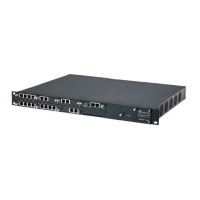Version 6.6 643 October 2014
Installation & Operation Manual 40. General SIP Configuration
4. For each query (primary or secondary), it requests to query the following
attributes (if they’re not configured as an empty string):
• LDAPPBXNumAttributeName
• LDAPOCSNumAttributeName
• LDAPMobileNumAttributeName
In addition, it queries the special attribute defined in
'LDAPPrivateNumAttributeName', only if the query key (primary or secondary) is
equal to its value.
5. If the query is found: the AD returns up to four attributes - Lync / OCS, PBX / IP
PBX, private (only if it equals Primary or Secondary key), and mobile.
6. The device adds unique prefix keywords to the query results to identify the query
type (i.e., IP domain). These prefixes are used as the prefix destination number
value in the Outbound IP Routing table to denote the IP domains:
• "PRIVATE" (PRIVATE:<private_number>): used to match a routing rule
based on query results of the private number
(MSLDAPPrivateNumAttributeName)
• "OCS" (OCS:<Lync_number>): used to match a routing rule based on query
results of the Lync client number (MSLDAPOCSNumAttributeName)
• "PBX" (PBX:<PBX_number>): used to match a routing rule based on query
results of the PBX / IP PBX number (MSLDAPPBXNumAttributeName)
• "MOBILE" (MOBILE:<mobile_number>): used to match a routing rule based
on query results of the mobile number (MSLDAPMobileNumAttributeName)
• "LDAP_ERR": used to match a routing rule based on a failed query result
when no attribute is found in the AD
Note: These prefixes are involved only in the routing and manipulation processes; they
are not used as the final destination number.
7. The device uses the Outbound IP Routing table to route the call based on the
LDAP query result. The device routes the call according to the following priority:
a. Private line: If the query is done for the private attribute and it's found, then
the device routes the call according to this attribute.
b. Mediation Server SIP address (Lync / OCS): If the private attribute does
not exist or is not queried, then the device routes the call to the Mediation
Server (which then routes the call to the Lync client).
c. PBX / IP PBX: If the Lync / OCS client is not found in the AD, it routes the
call to the PBX / IP PBX.
d. Mobile number: If the Lync / OCS client (or Mediation Server) is unavailable
(e.g., SIP response 404 "Not Found" upon INVITE sent to Lync client), and
the PBX / IP PBX is also unavailable, then the device routes the call to the
user's mobile number (if exists in the AD).

